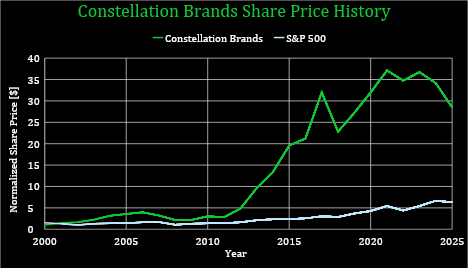Executive summary
Constellation Brands (STZ) demonstrates a compelling growth trajectory, driven by its dominant position in the high-end beer market, particularly with the Corona and Modelo brands. Strategic portfolio adjustments, including divestitures of non-core assets and targeted acquisitions like Sea Smoke and Hiyo, align with evolving consumer preferences. While the wine and spirits segment face challenges, STZ’s focus on premiumization, and operational efficiency positions it for sustained long-term value creation.
Key Highlights
Dominant Beer Portfolio
STZ maintains its leadership in the U.S. high-end beer market, leveraging exclusive distribution rights for Corona and Modelo, which continue to outperform industry averages.
Strategic Portfolio Transformation
The company is actively reshaping its wine and spirits portfolio, divesting non-core assets (e.g., SVEDKA) and investing in premium brands (Sea Smoke) and emerging categories (Hiyo). This strategic shift addresses evolving consumer preferences for premium and functional beverages.
Consumer-Centric Strategy
CEO Bill Newlands emphasizes a strong focus on consumer trends, driving investment decisions and portfolio adjustments.
Catalysts for growth
Premiumization Trend: The increasing consumer preference for high-quality, premium beverages provides a strong tailwind for STZ’s beer and premium wine offerings.
Emerging Beverage Categories: Investments in non-alcoholic functional beverages (Hiyo) and premium wines (Sea Smoke) tap into growing consumer demand for innovative and high-end products. Hiyo, an organic, non-alcoholic social tonic, targets health-conscious consumers.
Operational Efficiency: Ongoing initiatives to optimize brewery operations and enhance efficiency are expected to drive volume growth and profitability.
Business model
Constellation Brands operates as a leading international producer and marketer of beer, wine, and spirits, with a significant presence in the U.S., Mexico, New Zealand, and Italy.
The company’s strategy revolves around:
- Maintaining its leadership in the high-end beer market.
- Preimmunizing its wine and spirits portfolio to cater to evolving consumer preferences.
- Investing in emerging beverage categories
- Enhancing operational efficiency.
Modelo Especial’s strong growth is driven by its popularity among Hispanic consumers and a growing segment of younger, diverse drinkers. Premium wines like Sea Smoke target affluent consumers seeking high-quality, collectible wines. Hiyo targets health-conscious younger consumers.
Industry Analysis
Beer Industry
Premiumization and demand for low-alcohol and non-alcoholic options are key trends.
Wine Industry
Declining consumption among younger generations poses challenges, but the premium wine segment continues to grow.
Macroeconomic
E-commerce growth, inflationary pressures, and rising interest rates impact the industry.
Competitive Landscape
Beer: Key competitors include AB InBev, Diageo, Heineken, and Molson Coors. Below is the revenue, PE and market cap of competitors. The impact of the divestures on the EPS used in PE ratio explains the high PE of STZ.
| Competitors | Mkt Cap [$Billion] | PE | >Revenue [$Billion] |
|---|---|---|---|
| Anheuser-Busch INBev | 112.31 | 21.15 | 59.77 |
| Diageo | 45.56 | 15.59 | 20.21 |
| Heineken N.V. | 45.40 | 43.49 | 32.27 |
| Ambev SA | 36.74 | 14.00 | 89.45 |
| Carlsberg Group | 17.31 | 13.50 | 10.69 |
| Brown Forman | 16.15 | 16.24 | 4.06 |
| Molson Coors Beverage Company | 11.82 | 11.38 | 11.62 |
| Kirin Holdings Company | 11.33 | 29.3 | 15.03 |
| Boston Beer Company | 2.69 | 48.31 | 2.01 |
| Constellation Brands | 33.17 | 49.37 | 10.18 |
| Average | 34.09 | 20.94 | 27.23 |
STZ has made strategic acquisitions to expand its product range and reach new markets, for example STZ’s exclusive rights to Modelo and Corona in the US create a strong competitive advantage. The company has positioned itself as a premium brand in the industry, commanding higher prices. It has an extensive distribution network that reaches consumers worldwide with its diverse portfolio to cater to a wide range of consumer preferences. It is also known for its innovative product development, bringing exciting offers to the market.
Diageo posed a significant challenge to STZ with strong brands such as Guinness, Johnnie Walker and Smirnoff in the spirits and beer segments. Anheuser-Busch InBev is a significant challenge for STZ in the beer market with Budweiser and Stella Artois. Molson Coors is a direct competition in the mainstream and craft beer categories with Heineken competing on premium and import beer segments.
Investment Thesis
Financial Health
The growth of the beer business buffered the double-digit drop of the Wine & Spirits business due to the declining consumption of non-premium wines. The debt-to-equity ratio of 0.11 indicates a conservative capital structure and a current ratio of 1.1 short-term financial health. The net income recovered after the impact of Covid on the industry.
Strategic Initiatives
STZ focuses on sustainability, social equity, and responsible consumption, with commitments to reduce GHG emissions and invest in female and minority-led businesses.
Growth Drivers
Beer, with market leader brands, remains the cornerstone of growth marking its 29 consecutive quarter of depletion growth. Over the medium-term consumer demand for its brand is expected to drive strong volume growth. It also has an expansion plan for capacity additions from brewery efficiency and optimization initiatives.
Wine and spirits growth is expected to follow the significant transformation the portfolio underwent in the last years underpinning this transformation with further growth delivered through innovative varietal, betterment, and ready-to-drink cocktail extensions to these brands. The Wine & Spirits Business is also making progress broadening its avenues for growth by significantly increasing sales on direct-to-consumer channels and expanding their share in international markets.
Products such as Hiyo, will expand STZ’s presence in the non-alcoholic market and ready-to-drink category, with products with a more nutritious benefit.
Management
Constellation Brands’ management appears to be generally effective, with positive financial results, strong brand growth, and a focus on sustainability and innovation. The current CEO of Constellation Brands, Bill Newlands, has overseen a period of significant growth and strategic investments, particularly in the beer and spirits sectors, with a focus on premium brands and expansion into emerging markets.
Valuation
The Q3 results possibly caused an overreaction of the market, despite revenue growth of the beer business, which is about 82% of net sales. The current dividend yield is 2.26%, compared to 3% to 5% as attractive for the industry.
Based on the discounted cash flow valuation there is a potential upside of 59% and an average upside expectation of 37%. The low book value is as result of low gearing and short-term health.
| Growth | LT-growth | WACC | Fair value | Vs current | |
|---|---|---|---|---|---|
| High | 7.5% | 2.5% | 7.8% | $ 292.90 | 59% |
| Medium | 3.0% | 2.5% | 7.8% | $ 251.65 | 37% |
| Low | -2.0% | 2.5% | 7.8% | $ 211.51 | 15% |
| Average | $ 252.02 | 37% | |||
| Book value | $ 43.26 | ||||
| Current | $ 183.74 |
Below is the historical trend indicating the growth over the past 25 years, far from the decline in wine and spirits midst the portfolio restructuring. This is not buying depressed stock, as there is expected growth, which is supported by analysts and a healthy balance sheet with a history of growing revenue.

Risk factors
A secular decline is difficult to counter, but STZ’s strong brands could counter this with increased market share.
A looming problem is punitive tariffs on Mexico that will impact on Modelo and Corona business. This is priced into stock to a degree, but the full impact is uncertain. Careful pricing will be required to stay competitive and profitable.
The U.S. Surgeon General’s proposed cancer warning labels could negatively impact consumer perception of alcoholic beverages, potentially leading to decreased sales. However, STZ’s focus on non-alcoholic and low-carb options may offset some of this risk.
Innovation and spending on R&D to grow its position in the market is necessary to maintain its leading position and maintain and attract consumers; STZ has made this a key strategy.
Supply chain disruptions, particularly in the sourcing of raw materials from Mexico, could impact production and distribution.
Conclusion
Constellation Brands presents a compelling investment opportunity, driven by its strong beer portfolio, strategic portfolio transformation, and focus on premiumization. The company’s alignment with evolving consumer trends and operational efficiency positions is for sustained long-term growth.
This communication is for information and education purposes only and should not be taken as investment advice, a personal recommendation, or an offer of, or solicitation to buy or sell, any financial instruments. This material has been prepared without taking into account any particular recipient’s investment objectives or financial situation and has not been prepared in accordance with the legal and regulatory requirements to promote independent research. Any references to past or future performance of a financial instrument, index or a packaged investment product are not, and should not be taken as, a reliable indicator of future results. eToro makes no representation and assumes no liability as to the accuracy or completeness of the content of this publication.



